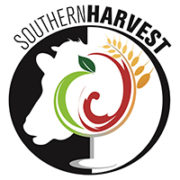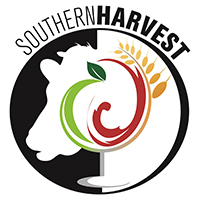With Autumn well underway many of you will have had a chance to experience the different fruit and veg the season has to offer. Each week we send our produce box subscribers a bit of information about new produce thats going into boxes, especially some of the more unusual things that people may not have heard of before. Here are Lucy's Veggie Musings all in one place for everyone to access:
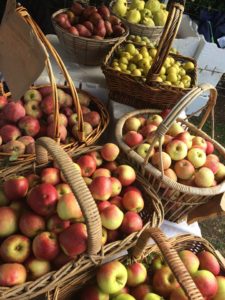
Apples
What's better than a new season apple? Crunchy, crisp, full of flavour and full of goodness. Did you know that apples in the supermarket can be stored for several YEARS before they're sold? Cold storage facilities have the air sucked out of them, leaving the apples mid-breath in a state of suspended animation. Don't get me wrong, I'm not adverse to cold storing apples for the Winter — people have been doing it for generations — but YEARS!? Years and years? It's wild to me (and frankly, kind of nasty). New season apples are fresh from the orchard, straight off the tree and into your produce box.
Celery
Did you know that celery used to be more expensive than caviar? In the early 20th century it was considered a rare delicacy, served in special celery vases. Lots of different celery varieties were grown, including some that were 'forced' in order to achieve a pure white variety.
Now, full disclosure, celery is one of the very few vegetables that I don't actually like. It isn't particularly exciting on its own — it famously requires more calories to eat than it provides — but it is a kind of flavour sponge. Use it in stocks, or what the Italians call soffrito: finely diced onion, carrot and celery that forms the basis of all good stews.
You might notice in your produce box that the bunches of celery are made up of the outer stems, rather than the whole plant. This cut-and-come-again method of picking allows our farmers to get multiple harvests, which means that the celery plants 'pay the rent' for a little longer. We'll still get the whole plant (including the heart) at the end of the season, but in the meantime the celery develops heaps more flavour. Win-win, right?
Nashi Pears
Nashi Pear are an Asian relative of the common European pear. They have a crisp, grainy texture and are usually smaller and rounder than European pears. They are delicious and juicy when eaten fresh and pair beautifully with cheese. They're also a good alternative to fresh apple in salads as they are similarly crisp, but don't oxidise and go brown so easily.
Traditionally nashi pears have also been used as a sweetener, and in Korean cooking they are used to tenderise beef for the popular dish bulgogi.
Warrigal Greens
This is a type of native spinach that grows in Australia, New Zealand and around East Asian and the Pacific. It's a good substitute for spinach or asian greens, however, before adding warrigal greens to any dish it's important to first blanch in boiling water for a minute or two, then drain and rinse (and discard the blanching water).This draws out some of the oxalic acid in the plant, which is totally fine to eat in small amounts (some people will happily eat smaller leaves of warrigal greens raw) but it will make you ill if you have too much. Once blanched you can use it in a stir fry, add it to a quiche, make a green smoothie or in any other way you'd usually use spinach.
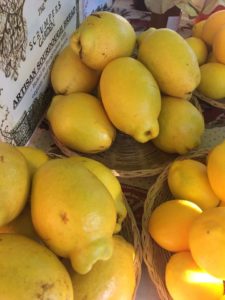
Quince
Beautiful Autumn quinces are in season now, and you may be lucky enough to have one of these lumpy, fuzzy, fragrant fruits in your produce box. Quinces are strange but delicious fruits that take a bit of time to prepare, but are worth the effort and will fill your kitchen with a lovely fruity rose smell. They need to be peeled, cored, and cooked for a long long time before eating, and a magical colour change occurs as the flesh goes from a pale cream to a rich, deep red. On the Millpost Merino Farm tour on Sunday we were served a lovely quince tart, made with a shortcrust base, almond frangipane filling and poached quinces on top. I've been thinking about a quince variation of the French classic tarte tatin: an upside-down caramel and fruit tart. With a big dollop of cream that would make a showstopper of a dessert for Easter lunch!
Collard Greens
Meet another brassica relative with a long history. They are popular in the American South, so I consulted a chef friend who grew up in North Carolina. She recommends cooking them with salted pork back fat or bacon, and serving with black eyed peas. Sprinkle with some toasted breadcrumbs for a little extra crunch.
Celeriac
Celeriac is a relative of celery, cultivated for its root bulb rather than stems. Celeriac can be eaten raw or cooked, and has a celery-like flavour. Use it in a soup or stew, or make a buttery mash! Sliced thinly it's delicious in a slaw or salad. Tidy up the root ball by trimming off the smaller roots (which just tend to trap dirt) to reveal the white centre. I find the celery flavour is more subtle than celery stems, and the texture is totally different.
Spaghetti Squash
Spaghetti Squash is a curcubit (meaning it belongs to the same broad family as pumpkin, cucumber and squash). This variety has a stringy texture when cooked, and the strands resemble spaghetti. Many people like to use spaghetti squash as a vegetable alternative to pasta! You can bake, boil, or steam the flesh to cook it and then simply scoop out the strands in the centre and serve with your favourite pasta sauce. What a world.
Sunchokes, Jerusalem Artichokes: whats in a name?
This is one of my FAVOURITE vegetable etymologies of all time. So I hope you're all ready to nerd out with me about this fascinating vegetable.
Sunchokes originated in North America. They are a species of sunflower and have distinctive yellow flowers, but were cultivated by First Nations people for the tubers which can be eaten raw, cooked, or pickled. Despite a rich pre-colonisation history I've never found any Indigenous names being commonly used for this vegetable.
Early European colonisers thought that they tasted like globe artichoke hearts, which is where we get the artichoke bit of the name from. Tubers were sent back to Europe and in Italy they were called girasole which means sunflower. Long story short, a non-Italian speaker mistranslated girasole as Jerusalem and the name was born! Jerusalem artichokes are also very popular in Israel and other Middle Eastern countries which has just further perpetuated the confusion.
In Europe they've also been called topinambour (after another colonial mishap and a story for another time) as well as Earth Apples, Canadian Potatoes, and the now-commonly used Sunchoke portmanteau which was invented in the 60's as a marketing tactic when American farmers attempted to revive interest in the crop.
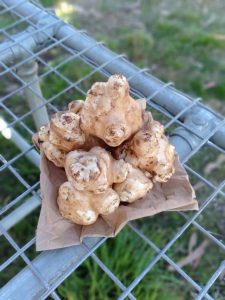
They have also earned the nickname Fartichokes. Yes it's true, sun chokes can cause flatulence for some people. This is because sun chokes store their carbohydrates as inulin rather than starch (like a potato). This actually makes them a good option for people with diabetes, because that inulin (and therefore the carbohydrates) aren't absorbed by the digestive tract but metabolised by colonic bacteria which is what causes the gas.
If you've been staying away from these tasty tubers for fear of tooting there are a few things you can try to get them back on your plate without worry! My number one advice is that moderation is key, and you can build up a tolerance over time, so start small and maybe try bulking out recipes with other root veggies like potato or parsnip and changing the balance over time. Late harvesting (after the frosts), or extended cold storage of the tubers seem to take some of the inulin out of the equation, and I've heard that adding fresh lemon juice or vinegar when cooking will do the same, although it will alter the flavour. Or you could make a lacto-fermented pickle in which more of the inulin is converted inside the jar, rather than inside your body.
I am a big fan of Jerusalem artichokes, especially when baked or fried to be nice and crispy with plenty of salt and a little squeeze of lemon juice to serve.
